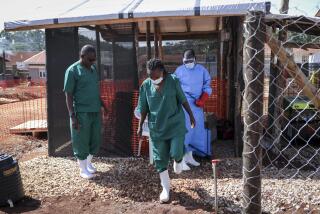WHO to issue guidelines on treating Ebola with blood, plasma therapies

- Share via
It’s an unproven, yet potentially hope-lifting treatment for Ebola: Pumping the blood of infection survivors into patients who are now suffering the deadly effects of the virus.
With experimental drug treatments or vaccines still months away from being deployed to West Africa, the World Health Organization has sanctioned the use of so-called convalescent blood therapies, which they say can be implemented much more quickly.
Since that ruling last month however, little else has been said about the experimental use of whole blood or plasma transfusion for Ebola patients.
“Major questions need to be answered about the safety and efficacy of convalescent therapies, and the feasibility of implementation in countries with shattered health systems and an acute shortage of medical staff,” the WHO said in an official statement Friday.
“WHO is also being asked to assess whether rapid scaling up of convalescent therapy is feasible to an extent that could begin to reduce the estimated 70.8% case fatality rate seen consistently across the three outbreak sites.”
The United Nations organization said it planned to issue guidelines early next week on convalescent therapies in those nations hardest hit by the epidemic -- Sierra Leone, Liberia and Guinea.
The concept of using convalescent serums is a simple one. Survivors of an illness like Ebola have built up antibodies against the virus, and those antibodies might help fight the disease in other people if they are given the blood product.
Such transfusions were used to fight illnesses before the advent of antibiotics and vaccines. The German surgeon Emil von Behring first used blood serum to treat diphtheria in 1890 and was awarded a Nobel Prize for his discovery.
Whether the technique is effective in fighting Ebola is unknown, however.
Two American doctors who were infected with Ebola while working in Africa -- Dr. Kent Brantly and Dr. Rick Sacra -- both received survivor blood antibodies and survived.
However, they also received experimental Ebola medications, and were evacuated to the United States where they received top-level supportive care.
It is impossible therefore to determine what effect, if any, the transfusion had, experts say.
The first time convalescent therapy was used to treat Ebola was in 1976, when a young woman in what is now the Democratic Republic of Congo was treated with the plasma of a patient who survived infection from the closely related Marburg virus, the WHO said. She did not survive.
The techinique was used again in 1995, during the Kikwit outbreak in the DRC. Eight patients received survivors’ blood, and seven of them recovered.
“However, as the study did not include a control group, no firm conclusions could be reached concerning whether the treatment alone was responsible for the favorable clinical outcome or even contributed to this outcome in some way,” the WHO said.
Even if the treatment is effective, experts note that the process is not without its risks.
“There is an inherent danger in any transfusion process, especially in an area where HIV is prevalent,” said Derek Gatherer, a bioinformatics researcher at Lancaster University in the United Kingdom.
“But the blood product industry has lots of experience in these issues by now, so hopefully they’ll be on top of it should African blood products start to be marketed extensively.”
Others say that while the use of convalescent serum is promising, the process requires a functional blood bank and can be time- and labor-intensive.
The WHO said these are issues it is hoping to answer.
“Some partners and donors are asking for rough estimates of what needs to be in place to support rapid implementation on the largest possible scale,” the WHO said in its statement.
“They have questions about the number of staff needed and their training requirements, safety risks and how to manage them, laboratory capacities and how to enhance them, specific needs for equipment and supplies, and what all of this might cost.”
Follow @montemorin for science news







